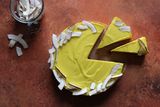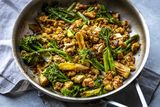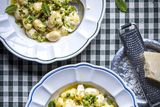Need something sweet with a little zest? Try Rachel Allen's lemon recipes for bars, pudding, cake and iced biscuits
Add a little zing to your day with a selection of lemon dainties
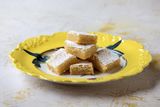
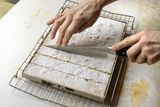
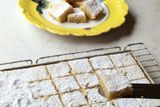
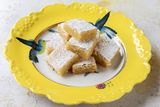


Lemons are just magic in the kitchen. From simple cakes and sponges to pies and puddings, lemons will invigorate even the simplest recipe with its fresh burst of zingy flavour.
Cute little lemon bars are just perfect for a mid afternoon treat with a cup of tea. The ones in the recipe below have a soft curd-like top sitting over a crumbly shortbread base; just delicious.
Read more
"Cute little lemon bars are just perfect for a mid afternoon treat with a cup of tea." Photo: Tony Gavin
Lemon bars
Makes 32
You will need:
For the topping, you will need:
To serve, you will need:
1 Preheat the oven to 180C (160 fan), 350F, Gas 4.
2 First make the base of the lemon bars. Place the plain flour, the butter and the caster sugar in a food processor and blend until the mixture has turned a creamy pale yellow colour and the butter is all rubbed in. If you wish, you can rub the butter by hand into the flour and the sugar in a mixing bowl.
3 Now press the crumbly shortbread mixture into the base of a 20cm by 30cm small Swiss roll tin and press down using your hands or a rolling pin so that it’s evenly covering the base of the tin. Bake in the preheated oven until golden and firm, about 15 minutes.
4 Meanwhile, make the filling. Place the caster sugar in a bowl and mix in the plain flour. Crack in the 4 eggs and the finely grated zest and lemon juice. Whisk well to combine and set aside.
5 When the shortbread is baked, pour the lemon topping over it and place back in the oven to bake for another 20 minutes until set in the centre.
Cut into bars or squares depending on your preference. Photo: Tony Gavin
"These have a soft curd-like top sitting over a crumbly shortbread base." Photo: Tony Gavin
Top Tip For the lemon bars, you need the juice of 2 lemons which is 100ml. If the lemons aren’t big enough for this amount, the squares will not set in the oven.
Little lemon creams
If you need a dessert made in jig-time, try whipping up these simple little lemon puddings, below. Like an old-fashioned posset, these are delicious served with a biscuit or meringue and cream. If you fancy, try adding a few sweet geranium, basil or lemon verbena leaves in with the cream at the beginning of the recipe.
Serves 10
You will need:
1 Put the cream and the caster sugar in a saucepan, bring to the boil and boil for 2 full minutes.
2 Remove from the heat, whisk in the lemon juice, pour into little cups, glasses or bowls and chill for 3 hours to set. Note: if you want to make these more zesty, just grate the rind of 1 lemon and mix with the lemon juice to add into the boiled cream and sugar.
"This is a cake that while just divine on the day that it’s baked, will keep well for a few days." Photo: Tony Gavin
Lemon and cardamom yoghurt cake
The lemon yoghurt cake recipe, below, uses the seeds from green cardamom pods, a spice that goes so well with citrus fruit with its sweet almost eucalyptus-like flavour that is just divine with lemon. It also calls for natural yoghurt which helps to give bakes a gorgeously soft and tender crumb. This is a cake that while just divine on the day that it’s baked, will keep well for a few days. You can use a bundt tin with the hole in the middle, or a classic spring form cake tin. Scattered with fresh raspberries or blueberries once it is iced, it’ll be as cute as a button on a cardi.
Serves 10-12
You will need:
For the icing, you will need:
To decorate, you will need:
To bake, you will need:
1 Preheat the oven to 180C (160 fan), 350F, Gas 4. Brush the insides of the bundt tin with melted butter. If you’re using a standard spring form cake tin, butter the sides and line the base with a disc of baking parchment.
2 Cream the butter until soft in a large bowl or in an electric food mixer. Add the sugar and the ground cardamom and beat until the mixture is light and fluffy. Beat in the lemon juice and zest, and the eggs, one at a time, beating well between each addition, then mix in the yoghurt.
3 Sift in the flour, the baking powder and the salt, folding in just until combined.
4 Tip the batter into the prepared tin and smooth the top with a spatula or palette knife. Bake the cake for 50–55 minutes or until a skewer inserted into the centre of the cake comes out clean. Allow to cool for just 5 minutes, then, if using a bundt tin, place a wire rack on the top and invert the cake so it is upside down, then remove the tin.
5 If using a standard cake tin, remove from the oven and allow to cool for 10 minutes, then loosen around the edges of the cake using a small, sharp knife and carefully remove from the tin before leaving on a wire rack to cool down completely.
6 As the cake cools, make the icing. Beat together the icing sugar, the ground cardamom and 25ml of the yoghurt, adding a tiny bit more yoghurt if the mixture seems too stiff. (It should be a thick drizzling consistency — too thin and the icing will slide off the cake — too thick and you won’t be able to drizzle it.)
7 Place the cake on a cake stand or serving plate, then drizzle the icing backwards and forwards from the centre to the outside of the cake in a zigzag pattern (or in zigzags across the top if it’s been made in a standard tin). Decorate with the raspberries immediately while the icing is still wet so they stick to the icing.
Rachel Recommends You can use ground cardamom for the cake overleaf, or for the freshest flavour, crush your own. To remove the seeds from green cardamom pods, lightly crush the pods, then pick out the blackish seeds and discard the husks. Crush the seeds using a pestle and mortar or place in a plastic bag and crush with a rolling pin.
Rachel Allen. Photo: Tony Gavin
Iced lemon hearts
Another treat to have with a cup of tea are these lovely iced lemon hearts. They’ll happily keep for a week in an airtight box or can be frozen. Feel free to decorate the icing before it sets with sprinkles, crystallised petals or hundreds and thousands.
Makes 30-40, depending on size
For the biscuits, you will need:
For the icing, you will need:
To bake, you will need:
1 Line 2 baking trays with parchment paper, or just line one tray if you’re baking in batches.
2 Sift the flour and the baking powder into a bowl, then mix in the ground almonds and the caster sugar.
3 Rub in the butter until the mixture resembles coarse breadcrumbs.
4 Mix the beaten egg with the finely grated lemon zest and the lemon juice. Pour into the dry ingredients and mix with your hands or a wooden spoon until you have a ball of dough.
5 Flatten the dough into a round about 1 or 2cm thick, then cover and place in the fridge for half an hour (the dough can be kept in the fridge for up to 48 hours).
6 Preheat the oven to 160C (140 fan), 325F, Gas 3.
7 Take the dough out of the fridge and roll it with the help of some flour on the work top and on the dough itself until it’s 5mm thick, making sure to slide a palette knife or fish slice under the dough regularly, to stop it sticking.
8 Using a cutter, cut the dough into heart shapes (or any other shape), then transfer on to the prepared baking tray or trays. Bake for 12-16 minutes, depending on the thickness of the dough and the heat of your oven, until the biscuits are golden and feeling slightly firm around the edges. Lift off the tray and carefully place on a wire rack to cool.
9 While the hearts are cooking, or cooling, you can make the icing. Sift the icing sugar into a mixing bowl and add in some, but not all, of the lemon juice. Add a bit more gradually and keep mixing until you have a fairly stiff but pliable mixture.
10 Place a palette knife (or a table knife if you don’t have a palette knife) in a jug of boiling water and with the help of the hot, wet knife, spread the icing over the hearts once they’re almost cool. Keep in a single layer for the icing to set before storing them away.
Read more
Join the Irish Independent WhatsApp channel
Stay up to date with all the latest news












